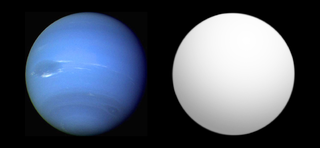
A Super-Earth is a type of exoplanet with a mass higher than Earth's, but substantially below those of the Solar System's ice giants, Uranus and Neptune, which are 14.5 and 17 times Earth's, respectively. The term "super-Earth" refers only to the mass of the planet, and so does not imply anything about the surface conditions or habitability. The alternative term "gas dwarfs" may be more accurate for those at the higher end of the mass scale, although "mini-Neptunes" is a more common term.

Kepler-4b, initially known as KOI 7.01, is an extrasolar planet first detected as a transit by the Kepler spacecraft. Its radius and mass are similar to that of Neptune; however, due to its proximity to its host star, it is substantially hotter than any planet in the Solar System. The planet's discovery was announced on January 4, 2010, in Washington, D.C., along with four other planets that were initially detected by the Kepler spacecraft and subsequently confirmed by telescopes at the W.M. Keck Observatory.

Kepler-10, formerly known as KOI-72, is a Sun-like star in the constellation of Draco that lies 607 light-years from Earth. Kepler-10 was targeted by NASA's Kepler spacecraft, as it was seen as the first star identified by the Kepler mission that could be a possible host to a small, transiting exoplanet. The star is slightly less massive, slightly larger, and slightly cooler than the Sun; at an estimated 11.9 billion years in age, Kepler-10 is 2.3 times the age of the Sun.

Kepler-42, formerly known as KOI-961, is a red dwarf located in the constellation Cygnus and approximately 131 light years from the Sun. It has three known extrasolar planets, all of which are smaller than Earth in radius, and likely also in mass.

A Mini-Neptune is a planet less massive than Neptune but resembling Neptune in that it has a thick hydrogen-helium atmosphere, probably with deep layers of ice, rock or liquid oceans.
Kepler-80, also known as KOI-500, is a red dwarf star of the spectral type M0V. This stellar classification places Kepler-80 among the very common, cool, class M stars that are still within their main evolutionary stage, known as the main sequence. Kepler-80, like other red dwarf stars, is smaller than the Sun, and it has both radius, mass, temperatures, and luminosity lower than that of our own star. Kepler-80 is found approximately 1,223 light years from the Solar System, in the stellar constellation Cygnus, also known as the Swan.
Kepler-68b is an exoplanet orbiting the Sun-like star Kepler-68 in the constellation of Cygnus. Discovered by planetary-transit methods by the Kepler space telescope in February 2013, it has a radius of 2.31 ± 0.07 that of Earth and a density of 2.46–4.3 g/cm3. It has an orbital period of 5.398763 days at a distance of about 0.0617 AU from its star. Doppler measurements were made to determine its mass to be 5.79 times that of Earth.
Kepler-32 is an M-type main sequence star located about 1053 light years from Earth, in the constellation of Cygnus. Discovered in January 2012 by the Kepler spacecraft, it shows a 0.58 ± 0.05 solar mass (M☉), a 0.53 ± 0.04 solar radius (R☉), and temperature of 3900.0 K, making it half the mass and radius of the Sun, two-thirds its temperature and 5% its luminosity.

Kepler-56 is a red giant in constellation Cygnus roughly 3,030 light-years (930 pc) away with slightly more mass than the Sun.

Kepler-90, also designated 2MASS J18574403+4918185, is a F-type star located about 2,790 light-years (855 pc) from Earth in the constellation of Draco. It is notable for possessing a planetary system that has the same number of observed planets as the Solar System.

Kepler-23 is a G-type main-sequence star about 2,860 light-years away in the northern constellation of Cygnus, the swan. With an apparent visual magnitude of 13.5, it is too faint to be seen with the naked eye. This star is similar in mass and temperature to the Sun, but is larger and more luminous. Kepler-23 is orbited by three known exoplanets.

Kepler-90g is a super-puff exoplanet orbiting the early G-type main sequence star Kepler-90, one of eight planets around this star discovered using NASA's Kepler space telescope. It is located about 2,840 light-years (870 pc) from Earth, in the constellation Draco. The exoplanet was found by using the transit method, in which the dimming effect that a planet causes as it crosses in front of its star is measured. It orbits its parent star about every 210.5 days at a distance of 0.71 astronomical units.

Kepler-138, also known as KOI-314, is a red dwarf located in the constellation Lyra, 219 light years from Earth. It is located within the field of vision of the Kepler spacecraft, the satellite that NASA's Kepler Mission used to detect planets transiting their stars.
Kepler-29 is a Sun-like star in the northern constellation of Cygnus. It is located at the celestial coordinates: Right Ascension 19h 53m 23.6018s, Declination +47° 29′ 28.437″. With an apparent visual magnitude of 15.456, this star is too faint to be seen with the naked eye. It is a solar analog, having a close mass, radius, and temperature as the Sun. Currently the age of the star has not been determined due to its 2780 light-year distance. As of 2016 no Jovian exoplanets of 0.9–1.4 MJ have been found at a distance of 5 AU.

KOI-256 is a double star located in the constellation Cygnus approximately 575 light-years (176 pc) from Earth. While observations by the Kepler spacecraft suggested the system contained a gas giant exoplanet orbiting a red dwarf, later studies determined that KOI-256 was a binary system composed of the red dwarf orbiting a white dwarf.
Kepler-89e, also known as KOI-94e, is an exoplanet in the constellation of Cygnus. It orbits Kepler-89.
Kepler-1229 is a red dwarf star located about 875 light-years (268 pc) away from the Earth in the constellation of Cygnus. It is known to host a super-Earth exoplanet within its habitable zone, Kepler-1229b, which was discovered in 2016.

HD 179070, also known as Kepler-21, is a star with a closely orbiting exoplanet in the northern constellation of Lyra. At an apparent visual magnitude of 8.25 this was the brightest star observed by the Kepler spacecraft to host a validated planet until the discovery of an exoplanet orbiting HD 212657 in 2018. This system is located at a distance of 354 light-years from the Sun based on parallax measurements, but is drifting closer with a radial velocity of −18.2 km/s.

Kepler-1638 is a G-type main-sequence star located about 5,000 light years away in the constellation of Cygnus. One known exoplanet has been found orbiting the star: Kepler-1638b.As of January 2021, Kepler-1638 is the farthest star with a known exoplanet orbiting in the habitable zone.
Kepler-167 is a K-type main-sequence star located about 1,119 light-years (343 pc) away from the Solar System in the constellation of Cygnus. The star has about 78% the mass and 75% the radius of the Sun, and a temperature of 4,884 K. It hosts a system of four known exoplanets. There is also a companion red dwarf star at a separation of about 700 AU, with an estimated orbital period of over 15,000 years.

















